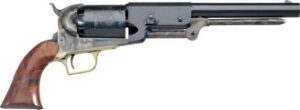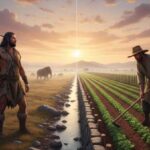As a hunter and gun enthusiast, I admire the inventor of the revolver, Samuel Colt. Prior to the revolver, the American armed forces used the muzzleloader. While the muzzleloader was a powerful weapon that could extend the lethal range of a soldier, it was a single shot weapon and took time to reload. In the time it took to reload a muzzleloader, an Indian could fire many arrows, leaving the soldiers at a disadvantage after the first volley of shots were fired. While a gun with at rotating cylinder had already been invented, the cylinder had to be rotated by hand.
With the newly devised percussion cap, Samuel Colt, who was an able-bodied seaman at the time, whittled a prototype out of wood while out at sea. Sam’s design allowed the act of pulling the hammer back not only to cock the gun but also to rotate the cylinder and align the next bullet. The timing of Colt’s idea could not have come at a better time. As Sam was preparing to demonstrate his new weapon, the massacre at the Alamo took place and the military desperately wanted a repeating gun to tilt the war to their advantage. Sam used the opportunity and went to Washington DC to lobby for his invention. He talked to anyone that would listen and he would often talk and drink with influential figures into the wee hours of the morning.
Ultimately, his partners did not see the direct results in sales that they had hoped for. They felt Sam was hobnobbing and partying at their expense. As a result, the company partners decided to split up, leaving Colt without access to a production facility.

Always a man seeking self-improvement, Samual Colt befriended Sam Morse, the inventor of the telegraph. Sam Morse convinced Colt that he needed to pay for good press to promote his invention. So Sam went to the Texas Rangers and got a testimonial from Samual Walker, the famous Texas Ranger. With Walker’s help, Colt redesigned his revolver and created the iconic “Walker 44,” the largest and most powerful black powder repeating handgun ever made. It was very well received, but as orders came in to put it into production, Sam didn’t have a factory to produce them. Without a production facility, Sam contracted Eli Whitney, who invented the cotton gin, to build his revolver.
With the success of the initial run, he was able to attract new investors and eventually went on to build his own production facility. He also continued to woo politicians and the media for the rest of his life as he focused on making the perfect gun. Over time, production improvements at his plant lowered the cost of his guns, making them affordable for the average American. This improvement occurred just as the Great Westward Expansion was taking place after the Civil War.
Sam Colt was not only a great marketer; he was also a man who never gave up on his idea even in the face of adversity. He ultimately achieved great economies of scale when the market timing was right. Sometimes the market needs to come to you as was the case with Sam Colt’s revolver changed the nature of war and tamed the Wild West.
What lessons from Samuel Colt can you apply to your business?












